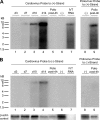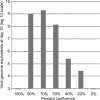Cultivation and serological characterization of a human Theiler's-like cardiovirus associated with diarrheal disease
- PMID: 20164225
- PMCID: PMC2863762
- DOI: 10.1128/JVI.02536-09
Cultivation and serological characterization of a human Theiler's-like cardiovirus associated with diarrheal disease
Abstract
Cardioviruses (e.g., Theiler's murine encephalomyelitis virus [TMEV]) are members of the Picornaviridae family that cause myocarditis and encephalitis in rodents. Recently, several studies have identified human cardioviruses, including Saffold virus (SAFV) and a related virus named human TMEV-like cardiovirus (HTCV). At least eight cardiovirus genotypes are now recognized, with SAFV and most strains of HTCV belonging to genotypes 1 and 2, respectively; genotype 2 strains are the most common in the population. Although a genotype 3 cardiovirus has recently been cultured (SAFV-3), the genotype 1 and 2 cardioviruses have been difficult to propagate in vitro, hindering efforts to understand their seroprevalence and pathogenicity. Here we present the isolation and characterization of a genotype 2 human cardiovirus (HTCV-UC6). Notably, successful cultivation of HTCV-UC6 from stool required the addition of cytokine-blocking antibodies to interrupt downstream antiviral pathways. Unlike SAFV-3, HTCV-UC6 exhibited slow replication kinetics and demonstrated only a moderate cytopathic effect. Serologic assays revealed that 91% of U.S. adults carry antibodies to the genotype 2 cardioviruses, of which 80% generate neutralizing antibodies, in agreement with previous data showing that cardiovirus infection is widespread in humans. We also demonstrate an acute cardiovirus seroconversion event in a child with diarrhea and vomiting, thus reporting for the first time evidence linking cardiovirus infection to diarrheal disease in humans.
Figures








References
-
- Altschul, S. F., W. Gish, W. Miller, E. W. Myers, and D. J. Lipman. 1990. Basic local alignment search tool. J. Mol. Biol. 215:403-410. - PubMed
-
- Brahic, M., J. F. Bureau, and T. Michiels. 2005. The genetics of the persistent infection and demyelinating disease caused by Theiler's virus. Annu. Rev. Microbiol. 59:279-298. - PubMed
-
- Chiu, C. Y., A. L. Greninger, K. Kanada, T. Kwok, K. F. Fischer, C. Runckel, J. K. Louie, C. A. Glaser, S. Yagi, D. P. Schnurr, T. D. Haggerty, J. Parsonnet, D. Ganem, and J. L. DeRisi. 2008. Identification of cardioviruses related to Theiler's murine encephalomyelitis virus in human infections. Proc. Natl. Acad. Sci. U. S. A. 105:14124-14129. - PMC - PubMed
Publication types
MeSH terms
Substances
Associated data
- Actions
Grants and funding
LinkOut - more resources
Full Text Sources
Medical

